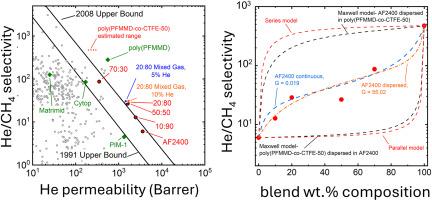混合多卤化膜具有较宽的He/CH4分离动态范围
IF 9
1区 工程技术
Q1 ENGINEERING, CHEMICAL
引用次数: 0
摘要
在这项研究中,提出了一种聚合物共混方法来制备具有宽动态范围的氦/甲烷分离膜。聚(PFMMD-co-CTFE-50)是一种分子量为50:50的全氟(2-亚甲基-4-甲基-1,3-二氧氧烷)(PFMMD)和三氟氯乙烯(CTFE)的共聚物,具有高氦/甲烷选择性和低氦渗透率,与Teflon AF2400混合,Teflon AF2400是一种具有低氦/甲烷选择性和超高氦渗透率的商用全氟聚合物。值得注意的是,通过简单地改变混合成分,混合膜的纯气和混合气氦气渗透率和氦气/甲烷选择性沿着2008 Robeson上界移动,跨越多个数量级,这使得这些膜能够在很宽的动态范围内工作,这一特征可以从具有不同成分的流中收集氦气。正如热分析、原子力显微镜(AFM)、界面能测量和Flory-Huggins模型所显示的那样,所有的共混物都表现出相分离的形态,无论它们的成分和制造方案如何。结果表明,相对于C-F键,C-Cl键的极性更大,聚四氟乙烯AF2400的表面能(PFMMD-co-CTFE-50)更大,这使得两种聚合物之间的相互作用非常不利。用广义麦克斯韦模型对渗透率数据进行理论分析,揭示了共混物微观结构和形态的更多细节,与原子力显微镜的结果基本一致。本文章由计算机程序翻译,如有差异,请以英文原文为准。

Blended polyhalogenated membranes exhibiting a wide dynamic range for He/CH4 separation
In this study, a polymer blending approach is proposed to fabricate membranes exhibiting wide dynamic range for helium/methane separation. Poly(PFMMD-co-CTFE-50), a 50:50 mol.% copolymer of perfluoro(2-methylene-4-methyl-1,3-dioxolane) (PFMMD) and chlorotrifluoroethylene (CTFE) exhibiting high helium/methane selectivity and low helium permeability, was blended with Teflon AF2400, a commercial perfluoropolymer exhibiting low helium/methane selectivity and ultra-high helium permeability. Remarkably, by simply changing the blend composition, the pure- and mixed-gas helium permeability and helium/methane selectivity of the blended membranes move along the 2008 Robeson upper bound while spanning multiple orders of magnitude, which makes these membranes capable of operating with a wide dynamic range, a feature that could enable harvesting helium from streams exhibiting different compositions. As shown by thermal analysis, atomic force microscopy (AFM), interfacial energy measurements and Flory-Huggins modeling, all blends exhibit a phase-separated morphology, irrespective of their composition and fabrication protocol. It was demonstrated that the larger polarity of the C–Cl bond relative to the C–F bond and the much larger surface energy of poly(PFMMD-co-CTFE-50) relative to Teflon AF2400 renders the interaction between the two polymers highly unfavorable. Theoretical analysis of permeability data with the generalized Maxwell model reveals additional details regarding the blend microstructure and morphology, which are in reasonable agreement with AFM results.
求助全文
通过发布文献求助,成功后即可免费获取论文全文。
去求助
来源期刊

Journal of Membrane Science
工程技术-高分子科学
CiteScore
17.10
自引率
17.90%
发文量
1031
审稿时长
2.5 months
期刊介绍:
The Journal of Membrane Science is a publication that focuses on membrane systems and is aimed at academic and industrial chemists, chemical engineers, materials scientists, and membranologists. It publishes original research and reviews on various aspects of membrane transport, membrane formation/structure, fouling, module/process design, and processes/applications. The journal primarily focuses on the structure, function, and performance of non-biological membranes but also includes papers that relate to biological membranes. The Journal of Membrane Science publishes Full Text Papers, State-of-the-Art Reviews, Letters to the Editor, and Perspectives.
 求助内容:
求助内容: 应助结果提醒方式:
应助结果提醒方式:


